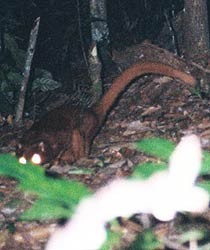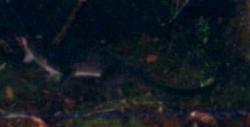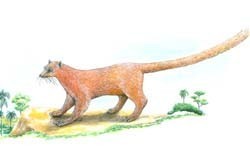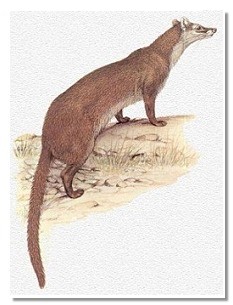
January 3, 2007

Perhaps I got it wrong?
“New” Borneo Animal “Discovered”
Back on December 5, 2005, I shared the news that apparently a new red-furred animal larger than a domestic cat had reportedly been discovered on Borneo, Indonesia.

On December 5, 2005, the World Wide Fund for Nature (WWF) announced that they had discovered the first new carnivore to be found in the region since the Tonkin otter-civet emerged in Vietnam in 1930. Also, the WWF said it would be the first new mammal to be specifically found on the island of Borneo since the Borneo ferret-badger in 1895.
The new carnivore was found in Kayan Mentarang National Park in Kalimantan, the Indonesian part of Borneo.
According to reports in The Times of London and other sources the "only evidence that exists are photographs taken by an automatically triggered camera on a jungle trail in Indonesia in 2003. Infuriatingly, a large leaf obscured the creature’s face as the shutter went off."
Stephen Wulffraat, discoverer of the so-far unnamed animal, said: “We showed the photos to locals who know the wildlife of the area, but nobody had ever seen this creature before. We also consulted several Bornean wildlife experts. Some thought it looked like a lemur, but most were convinced it was a new species of carnivore.”
The photographs showed, wrote reporters Nick Meo and Nigel Hawkes, "an enigmatic, red-furred creature with tiny ears and distinctive markings. The leaf that obscures its face makes it impossible to say if it has a pointed snout like a dog or fox, or a flat face like a cat. A second photo, from behind, shows it to have a long, bushy tail rather like a fox, and large hind legs. It is slightly larger than a domestic cat."
The mystery animal’s pictures were initially taken by WWF field researchers in 2003, but the photos were kept unpublished by the WWF as research continued. The WWF decided to make public the photos with the release of a book about Borneo.
The animal is slightly larger than a domestic cat with dark red fur and a long bushy tail. It was photographed twice by a night camera trap.
Was It Hose’s Palm Civet?
Two days later on January 7, 2006, I posted more, after some research and looking at various other cam photos (such as these, below). I speculated that the animal photographed might be an extinct species of civet rediscovered.


The Wildlife Conservation Society, Upper Baram Project, Malaysia, had obtained an interesting series of camera trap photos in 2004 on the unlogged areas of Mount Murud Kecil, Sarawak. One is of this slender unknown civet, shown above, with a very long tail, pale underparts and white around the muzzle, similar to Hose’s palm civet. This individual was photographed on the ridge of the mountain, far from the streams which are the Hose’s palm civet’s supposed habitat.
I compared the photos from Mount Murud Kecil (directly above), with this drawing (below) of the newly discovered Borneo "civet." I thought in 2005 that a good case could to be made that the allegedly “new Borneo animal” was the supposedly extinct (since 1955) Hose’s palm civet. I observed it might be similar to the above photographed "underreported" unknown civet from Mount Murud Kecil.

As opposed to this (2005) media-celebrated “new animal,” I said it seemed more proper to say this might be a probable “rediscovery” of an extinct form, the Hose’s palm civet, as can be seen in a drawing from the excellent Lioncrusher reference site and shown directly below this paragraph. The Hose’s palm civet appeared to me to be what was photographed from Borneo.

Also, the "new" Borneo animal and the unknown Mount Murud Kecil civet reinforced, positively, the use of camera traps, as a method to show "hidden" animals.
The "new" Borneo animal, I speculated, might be an example of a rediscovered (no longer extinct) Hose’s Palm Civet (Diplogale hosei).
Or A Giant Flying Squirrel?
According to a new series of January 2007 blogs being written by Darren Naish, detailing the new findings by Erik Meijaard and colleagues (Mammal Review, 36, 318-324), I was wrong.
In their 2007 paper, “New Bornean carnivore’ is most likely a little known flying squirrel,” Erik Meijaard, Andrew C. Kitchener, and Chris Smeenk, saw something else in the photographs. The summary in their abstract notes:
We analysed two camera-trap photos of an alleged new species of carnivore from Kalimantan, Borneo, Indonesia.
Comparisons of the features seen in the photos with morphological features of 17 similar-looking species from the region suggest that the animal is not a new species of carnivore, as had been widely speculated, but is most likely a rarely seen species of flying squirrel, probably Aeromys thomasi.
Therefore, the scientists have “re-identified” the Borneo mammal, and Naisha agrees, as “a giant flying squirrel,” probably Aeromys thomasi. (See an illustration of Aeromys tephromelas at top.) Southeast Asia is the home of two large flying squirrels, the Black flying squirrel, Aeromys tephromelas and the Thomas’ flying squirrel, Aeromys thomasi.
However, Meijaard, et alii, do bring forth a cautionary note:
We advocate continuing adherence to the formalities of species description based on actual specimens and a formal review process. Even informal announcements about possible new species based on photographs or other indirect evidence should adopt a cautionary approach. All the possibilities should be eliminated using any available means, such as comparative morphometrics and assessments of body shape and posture, and coat colour.
So, actually, we really don’t know what it was without direct physical evidence.
BTW, here’s an interesting coincidence. I thought it might be Hose’s palm civet, which was first described by Thomas in 1892, 1915. If it is Thomas’ flying squirrel, Aeromys thomasi, I see the person that described this animal was Hose, in 1900. It appears Hose and Thomas were friends, associates, or, at least, overlapped each other in their discoveries. Apparently, their lives are intertwined, once again, in this 2003-2007 dilemma.
About Loren Coleman
Loren Coleman is one of the world’s leading cryptozoologists, some say “the” leading living cryptozoologist. Certainly, he is acknowledged as the current living American researcher and writer who has most popularized cryptozoology in the late 20th and early 21st centuries.
Starting his fieldwork and investigations in 1960, after traveling and trekking extensively in pursuit of cryptozoological mysteries, Coleman began writing to share his experiences in 1969. An honorary member of Ivan T. Sanderson’s Society for the Investigation of the Unexplained in the 1970s, Coleman has been bestowed with similar honorary memberships of the North Idaho College Cryptozoology Club in 1983, and in subsequent years, that of the British Columbia Scientific Cryptozoology Club, CryptoSafari International, and other international organizations. He was also a Life Member and Benefactor of the International Society of Cryptozoology (now-defunct).
Loren Coleman’s daily blog, as a member of the Cryptomundo Team, served as an ongoing avenue of communication for the ever-growing body of cryptozoo news from 2005 through 2013. He returned as an infrequent contributor beginning Halloween week of 2015.
Coleman is the founder in 2003, and current director of the International Cryptozoology Museum in Portland, Maine.
Filed under Breaking News, Cryptomundo Exclusive, CryptoZoo News, Cryptozoologists, Cryptozoology, Extinct, New Species